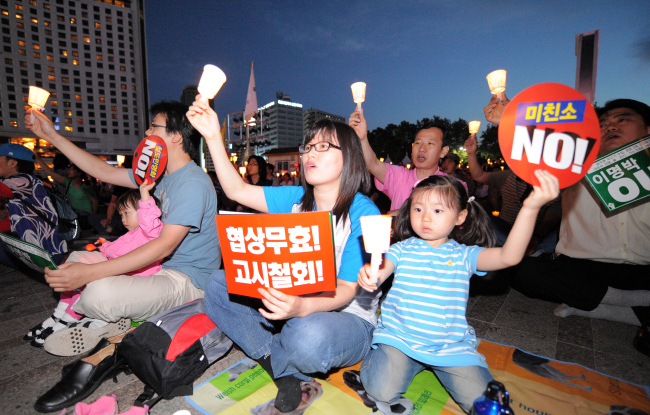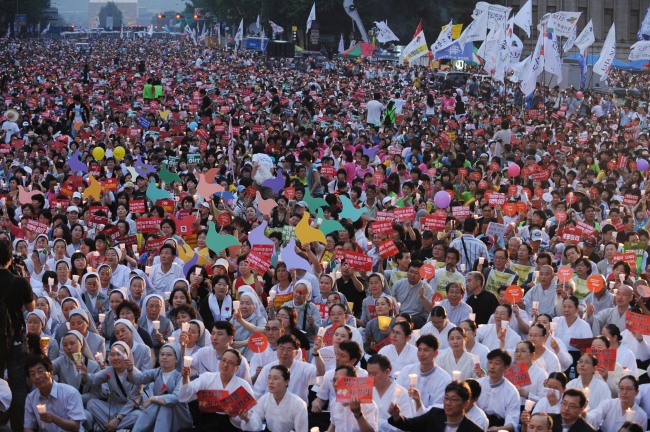When millions of South Koreans flocked to central Seoul to hold a candlelight vigil against a beef import agreement with the United States in 2008, social activist Ha Seung-chang was “inspired” to see how Korean civil society had developed over the years.
Ha, the head of nonprofit group Think Cafe, began to engage in civic movement in the early 1980s. He said that he witnessed a new breed of social activism that was open, participatory and peer-driven during the 2008 candlelight vigils.
“In 2008, citizens voluntarily took to the streets to voice concerns over their own problems and tackle them,” the 54-year-old activist told The Korea Herald.
“The candlelight rallies made me realize that the traditional methods of social movements driven by civic groups were fundamentally changing.”
Ha, the head of nonprofit group Think Cafe, began to engage in civic movement in the early 1980s. He said that he witnessed a new breed of social activism that was open, participatory and peer-driven during the 2008 candlelight vigils.
“In 2008, citizens voluntarily took to the streets to voice concerns over their own problems and tackle them,” the 54-year-old activist told The Korea Herald.
“The candlelight rallies made me realize that the traditional methods of social movements driven by civic groups were fundamentally changing.”

In South Korea, civil society, meaning the nonprofit sector between the state, the market and households, has been a driving force for democracy, serving as an opposition force to strong state powers.
But the nonprofit sector, also known as the third sector, is now at a crossroads, confronting challenges to position itself amid the diminishing support from citizens and advanced technology that substitutes civic groups’ role in mobilizing people.
While experts remain divided over when Korea’s civil society emerged, it is thought that the mass mobilization of the public dates back to the Japanese colonial rule in the first half of the 1900s.
In a fight for independence, street demonstrations took place at times across the nation, despite fierce crackdowns by the Japanese.
In August 1945, Koreans eventually gained independence from Japan, but had to continue their fight for democracy under military regimes that dominated the nation through oppression.
Despite their efforts to seek legitimacy on the back of the public’s anti-communist sentiment and rapid economic development, the oppressive rulers – Syngman Rhee (1948-60), Park Chung-hee (1963-1979) and Chun Doo-hwan (1980-1987) – faced a series of pro-democracy protests including the April Revolution in 1960 and the Gwangju Uprising in 1980.
As Korea’s rapid economic growth led to an increase in educated students and the middle class, Korean students spearheaded a nationwide movement for democracy in 1987, challenging the decades-long military rule and demanding constitutional change to guarantee a democratic election.
The uprising ended in success, achieving what scholars here view as “procedural democracy,” as the military ruler Chun stepped down and agreed to adopt a direct presidential election system.
The social activist Ha, who is also the author of the recently-published book “My story of Civil Movement,” was one of the students protesting on the streets along with millions of others.
“The June Uprising was an important experience for Koreans to expand democracy and realize that a collective movement can bring about a positive change in society,” said Ha, pointing out that the historic event paved the way for Korea’s civil society to flourish.
Since the 1987 democratization, Korea saw its number of nonprofit groups increase from 3,898 in 1996 to 15,180 in 2002, according to data from the Information Center for Civic Movements. With no official statistics available, experts estimate that the total number would top 30,000 or more in 2015.
While the civil movement continued to focus on promoting democracy by demanding political and social reforms in the 1990s, civic groups started to expand their interests into various issues ranging from the environment and human rights to gender equality.
Protests and candlelight vigils remained a common form of Korean civic movement, with the number of mass gatherings hovering around 10,000 in the 2000s. The number hit a record high in 2008 due in part to the anti-U.S. beef imports campaign, with nearly 14,000 protests held across the nation, according to the National Police Agency.
The heyday for civic groups came in the 2000 general election, when an alliance of some 900 nongovernmental groups released a blacklist of some 100 politicians who they saw as unqualified to serve in the National Assembly, urging voters to reject them. Some of the listed candidates had criminal records, while others were involved in corruption.
The campaign heavily influenced the general election, with political parties disqualifying candidates named on the list. Nearly 70 percent of listed candidates who ran in the election failed to secure a seat.
“Since then, Korea’s established civic groups earned the trust of ordinary citizens and took the lead in candlelight rallies throughout the 2000s,” Park Young-sun, a sociology professor at Kyung Hee University, told The Korea Herald.
Korean society saw some signature demonstrations in the late 1990s and early 2000s, including the minority shareholders movement to protect rights infringed by corporate interests in the aftermath of the 1997 financial crisis, the Misun-Hyosun vigil in 2002 for two teenage girls killed by a U.S. military vehicle and the anti-impeachment vigil in 2004 to stop President Roh Moo-hyun from being impeached by the opposition bloc.
But nonprofit groups have gradually lost ground in Korea in recent years.
Kim So-ra, a 26-year-old university student who has closely worked with nongovernmental organizations in development sector, says she doubts civic groups’ accountability.
“It seems like there are few nonprofit organizations that are financially independent,” Kim told The Korea Herald. “When they rely on other sources like the government and political groups for funding, how can they be solely representing citizens?”
Joo Sung-soo, a professor who teaches civil society studies at Hanyang University, said that low membership of nonprofit groups among the general population had become the biggest concern.
“The low membership of civic groups means that they suffer from a shortage of funding,” Joo told The Korea Herald. “The lack of money limits their roles to criticizing the government and its policies rather than engaging at grassroots in local communities.”
According to government statistics, only 1 in 10 Koreans aged 13 or older has joined a nonprofit organization as of 2013, illustrating eroding representation of ordinary Koreans in civic groups.
And the ideological polarization in civil society contributes to the public’s growing indifference to civil movement led by non-profit groups.
“Unfortunately, ideological radicalism is sapping the civic movement’s popularity,” he said, adding that the political division had escalated when the conservative Lee Myung-bak administration taking office.
Joo said that the divided country was destined to have clashes over political ideology as South Korea remains at war with North Korea.
“But since 2008, the feud intensified over how to view North Korea and the United States, especially with President Lee unconditionally allowing right-wing civic groups into civil society,” he claimed.

With nonprofit groups losing their influence and becoming institutionalized, they have grown apart from citizens, which might have propelled Koreans to pour onto the streets in the 2008 candlelight vigil, the sociology professor Park said.
Korea had suspended beef imports from the U.S. after the country reported in 2003 the first case of mad cow disease that scientists said could infect humans with Creutzfeldt-Jakob disease.
When the Korean government struck a deal to import U.S. beef that critics said were not assured of safety in 2008, a high school girl went onto an Internet forum to express her worries. Her posting immediately went viral, inducing thousands of Koreans to hold candlelight vigils across the nation.
“It is a much-needed progress that citizens voluntarily mobilized themselves to voice their opinions thanks to Internet,” she said. “But the candlelight vigil could also mean a limitation on Korean civil society as it did not help improve the link between citizens and the policy-making process.”
Lee Chung-hee, political professor at Hankuk University of Foreign Studies, pointed to Korea’s “weak” political party system failing to fully represent citizens’ interests as being behind the problem in such mobilizations.
“Individual protests result from the nation’s lack of established mediating institutions such as political parties and civic groups that can reflect citizens’ demands in the policy-making process,” Lee told The Korea Herald.
But such movement without organizing power is quick to gain momentum and then lose steam, making it hard to have their voices heard in the political realm. “If the trend continues, it could further undermine the na
tion’s already-faltering representative democracy,” Lee said.
Hopefully, it will sound an alarm to the established political parties and civic groups so that they could reform themselves and increase citizens’ representation in the political system, he added.
While the longing for democracy and the powerful experience of toppling the authoritarian regime shaped the country’s civil society until the early 2000s, the rise of the Internet and a tech-savvy generation might require a change in how civic movements are run.
Ha, who considers himself as a first-generation social activist, said that modern-day citizens become aware of social issues online and closely respond to problems affecting their own lives, reducing the room for civic groups to mobilize them in a conventional way.
“Society changed, and so should civic groups,” Ha said, adding that first-generation non-profit organizations at the forefront of civil society should listen more carefully to citizens at the grassroots level.
“To create a lasting social impact, we should adapt to a new environment in which technology enables face-to-face interactions,” he said. “Because that is the way to expand democracy.”
By Ock Hyun-ju (laeticia.ock@heraldcorp.com)









![[Hello India] Hyundai Motor vows to boost 'clean mobility' in India](http://res.heraldm.com/phpwas/restmb_idxmake.php?idx=644&simg=/content/image/2024/04/25/20240425050672_0.jpg&u=)








